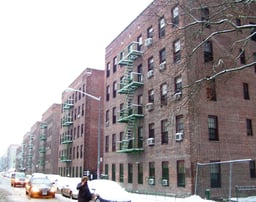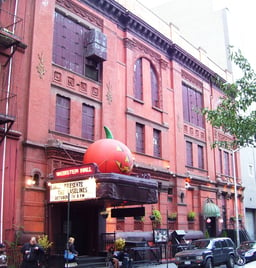East Village, Manhattan

East Village, Manhattan

East Village | |
|---|---|
Neighborhood in Manhattan | |
 Location in New York City | |
| Coordinates:40°43′41″N 73°59′10″W [217] | |
| Country | |
| State | |
| City | |
| Borough | |
| Community District | Manhattan 3[1] |
| Named | 1960s[2] |
| Area | |
| • Total | 1.99 km2(0.768 sq mi) |
| Population (2016)[3] | |
| • Total | 63,347 |
| • Density | 32,000/km2(82,000/sq mi) |
| Ethnicity | |
| • White | 65.5% |
| • Asian | 14.9 |
| • Hispanic | 12.4 |
| • Black | 3.9 |
| • Other | 3.3 |
| Economics | |
| • Median income | $74,265 |
| Time zone | UTC−5 (Eastern) |
| • Summer (DST) | UTC−4 (EDT) |
| ZIP code | 10003, 10009 |
| Area code(s) | 212, 332, 646, and 917 |
The area was once generally considered to be part of the Lower East Side, with a large Russian, Ukrainian and Jewish population, but gradually changed and by the late 1960s, many artists, musicians, students and hippies began to move into the area, attracted by cheap rents and the base of Beatniks who had lived there since the 1950s. The neighborhood became a center of the counterculture in New York, and is known as the birthplace and historical home of many artistic movements, including punk rock[5] and the Nuyorican literary movement.[6] It has also been the site of protests and riots. Since at least the 2000s, some have argued that gentrification has changed the character of the neighborhood.[7]
East Village is part of Manhattan Community District 3 and its primary ZIP Codes are 10003 and 10009.[1] It is patrolled by the 9th Precinct of the New York City Police Department.
East Village | |
|---|---|
Neighborhood in Manhattan | |
 Location in New York City | |
| Coordinates:40°43′41″N 73°59′10″W [217] | |
| Country | |
| State | |
| City | |
| Borough | |
| Community District | Manhattan 3[1] |
| Named | 1960s[2] |
| Area | |
| • Total | 1.99 km2(0.768 sq mi) |
| Population (2016)[3] | |
| • Total | 63,347 |
| • Density | 32,000/km2(82,000/sq mi) |
| Ethnicity | |
| • White | 65.5% |
| • Asian | 14.9 |
| • Hispanic | 12.4 |
| • Black | 3.9 |
| • Other | 3.3 |
| Economics | |
| • Median income | $74,265 |
| Time zone | UTC−5 (Eastern) |
| • Summer (DST) | UTC−4 (EDT) |
| ZIP code | 10003, 10009 |
| Area code(s) | 212, 332, 646, and 917 |
History
Early development
Dutch settlement and upscale area
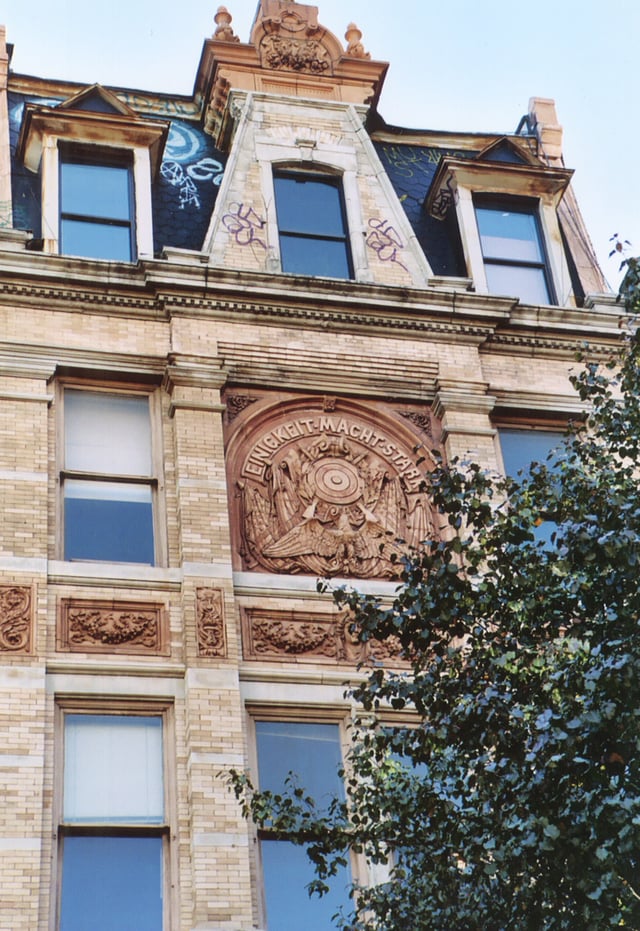
Former German-American Shooting Society Clubhouse at 12 St Mark's Place (1885). East Village once had a sizable Little Germany, an area within which this building is located.
The area that is today known as the East Village was originally occupied by the Lenape Native Americans.[8] [] The Lenape moved between different seasons, moving toward the shore to fish during the summers, and moving inland to hunt and grow crops during the fall and winter.[9] [] Manhattan was purchased in 1626 by Peter Minuit of the Dutch West India Company, who served as director-general of New Netherland.[10][11] [] While most of New Netherland's residents lived at what is now the Financial District, within Manhattan's southern tip, there were numerous plantations called "bouwerij" ("boweries") owned by Dutch, as well as smaller plots owned by freed or "half-free" blacks. Native Americans continued to live to the north of the plantations.[8] [] [11] [] The area west of the Bowery between Astor Place and Prince Street constituted one of the largest clusters owned by black landowners, as well as the "only separate enclave" of this type within Manhattan.[12] []
There were several "boweries" within what is now East Village. Bowery no. 2 passed through several inhabitants, before the eastern half of the land was subdivided and given to Harmen Smeeman in 1647. Peter Stuyvesant, the director-general of New Netherland, owned adjacent bowery no. 1 and bought bowery no. 2 in 1656. Stuyvesant's manor, also called Bowery, was located near what is now 10th Street between Second and Third Avenues. Though the manor burned down in the 1770s, his family held on to the land for over seven generations, until a descendant began selling off parcels of the property in the early 19th century.[8] [] [13] [] Bowery no. 3 was located near today's 2nd Street between Second Avenue and the modern street named Bowery. It was owned by Gerrit Hendricksen in 1646 and later given to Philip Minthorne by 1732. The Minthorne and Stuyvesant families both owned slaves on their farms.[13] [] According to an 1803 deed, Stuyvesant's slaves were to be buried in a cemetery plot at St. Mark's Church in-the-Bowery.[14] The Stuyvesants' estate later expanded to include two Georgian-style manors: the "Bowery House" to the south and "Petersfield" to the north.[8] [] [13] []
Much of these farms had become wealthy country estates by the middle of the 18th century. The Stuyvesant, DeLancey, and Rutgers families would come to own most of the land in the Lower East Side, including the portions that would later become the East Village.[9] [] By the late 18th century, Lower Manhattan estate owners started having their lands surveyed in order to facilitate the future growth of Lower Manhattan into a street grid system. The Stuyvesant plot, surveyed in the 1780s or 1790s, was planned to be developed with a new grid surrounding around Stuyvesant Street, a street that ran compass west-east rather than at the 29-degree offset of the modern grid system laid out under Commissioners' Plan of 1811. Stuyvesant Street formed the border between former boweries 1 and 2, and the grid surrounding it included four north-south and nine west-east streets.[8] [] [13] [] Because each landowner had done their own survey, there were multiple different street grids that did not align with each other. Various state laws, passed in the 1790s, gave the city of New York the ability to plan out, open, and close streets.[8] [] [13] [] The final plan, published in 1811, resulted in the current street grid north of Houston Street, and most of the streets in the modern East Village were conformed to this plan, except for Stuyvesant Street.[15] []
Wealthy townhouses dotted the dirt roads for a few decades in the early 19th century. At the time, East Village had the cachet of Sutton Place, another secluded rich enclave in Manhattan.[16]
Immigrant neighborhood
Speculative land owners began building multi-unit dwellings on lots meant for single family homes, and began renting out rooms and apartments to the growing working class, including many immigrants from Germany. From roughly the 1850s to first decade of the 20th century, the neighborhood has the third largest urban population of Germans outside of Vienna and Berlin, known as Klein Deutschland ("Little Germany"). It was America's first foreign language neighborhood; hundreds of political, social, sports and recreational clubs were set up during this period, and some of these buildings still exist. However, the vitality of the community was sapped by the General Slocum disaster on June 15, 1904, in which over a thousand German-Americans died.
Later waves of immigration also brought many Poles and, especially, Ukrainians to the area, creating a Ukrainian enclave in the city. Since the 1890s there has been a large concentration roughly from 10th Street to 5th Street, between 3rd Avenue and Avenue A. The post-World War II diaspora, consisting primarily of Western Ukrainian intelligentsia, also settled down in the area. Several churches, including St. George's Catholic Church; Ukrainian restaurants and butcher shops; The Ukrainian Museum; the Shevchenko Scientific Society; and the Ukrainian Cultural Center are evidence of the impact of this culture on the area.[17]
The area originally ended at the East River, to the east of where Avenue D was later located, until landfill – including World War II debris and rubble shipped from London – was used to extend the shoreline to provide foundation for the Franklin D. Roosevelt Drive.[18]
New neighborhood

A wall in the East Village in 1998, featuring a mural of two men
Until the mid-1960s, the area was simply the northern part of the Lower East Side, with a similar culture of immigrant, working class life. In the 1950s, the migration of Beatniks into the neighborhood later attracted hippies, musicians and artists well into the 1960s.[2] The area was dubbed the "East Village", to dissociate it from the image of slums evoked by the Lower East Side. According to The New York Times, a 1964 guide called Earl Wilson's New York wrote that "artists, poets and promoters of coffeehouses from Greenwich Village are trying to remelt the neighborhood under the high-sounding name of 'East Village.'"[2]
Newcomers and real estate brokers popularized the new name, and the term was adopted by the popular media by the mid-1960s.[19][20] In 1966 a weekly newspaper, The East Village Other, appeared and The New York Times declared that the neighborhood "had come to be known" as the East Village in the edition of June 5, 1967.[2]
Cultural hub
Music scene

Patti Smith, seen here in Copenhagen in 1976, is one of the many poets, musicians and artists who got their start in the East Village[21]
In 1966, Andy Warhol promoted a series of multimedia shows, entitled "The Exploding Plastic Inevitable", and featuring the music of the Velvet Underground, in a Polish ballroom on St. Marks Place. On June 27, 1967, the Electric Circus opened in the same space with a benefit for the Children's Recreation Foundation whose chairman was Bobby Kennedy. The Grateful Dead, The Chambers Brothers, Sly and the Family Stone, and the Allman Brothers Band were among the many rock bands that performed there before it closed in 1971.
On March 8, 1968, Bill Graham opened the Fillmore East in what had been a Yiddish Theatre on Second Avenue at East 6th Street in the Yiddish Theater District. The venue quickly became known as "The Church of Rock and Roll", with two-show concerts several nights a week. While booking many of the same bands that had played the Electric Circus, Graham particularly used the venue, as well as its West Coast counterpart, to establish in the US British bands such as The Who, Pink Floyd, The Jimi Hendrix Experience, Cream and Led Zeppelin. The Fillmore East closed in 1971.
CBGB, the nightclub considered by some to be the birthplace of punk music, was located in the neighborhood, as was the early punk standby A7. No Wave and New York hardcore also emerged in the area's clubs. Among the many important bands and singers who got their start at these clubs and other venues in downtown Manhattan were Patti Smith, Arto Lindsay, the Ramones, Blondie, Richard Hell and the Voidoids, Madonna, Talking Heads, Television, the Plasmatics, Glenn Danzig, Sonic Youth, the Beastie Boys, Anthrax, and The Strokes.
Few icons of the punk scene remain in the neighborhood as it changed. Richard Hell lives in the same apartment he has lived in since the 1970s, and Handsome Dick Manitoba of The Dictators owns Manitoba's bar on Avenue B.
Art scene
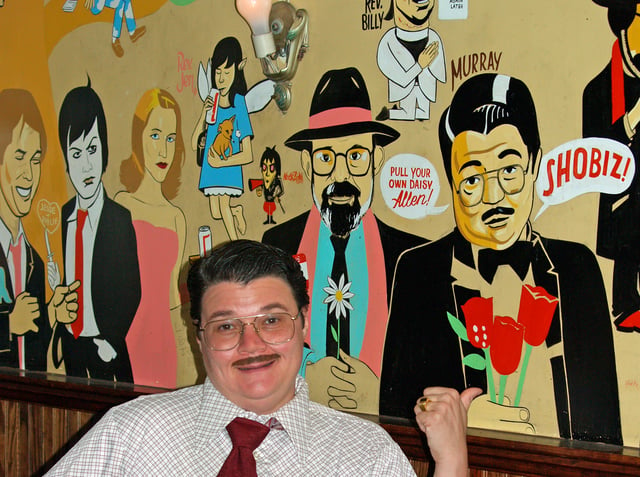
Performer Murray Hill with the "Downtown Legends" wall at Mo Pitkins' House Of Satisfaction, depicting artists of the East Village performance scene, including the Reverend Jen, Nick Zedd, Allen Ginsberg, Reverend Billy
Over the last 100 years, the East Village and the Lower East Side have contributed significantly to American arts and culture in New York.[22] The neighborhood has been the birthplace of cultural icons and movements from the American gangster to the Warhol Superstars, folk music to punk rock, anti-folk to hip-hop, advanced education to organized activism, experimental theater to the Beat Generation and the community of experimental musicians, composers and improvisers now loosely known as the Downtown Scene.
Club 57, on St. Marks Place, was an important incubator for performance art and visual art in the late 1970s and early 1980s, followed by Now Gallery, 8BC and ABC No Rio.
During the 1980s, the East Village art gallery scene helped to galvanize a new post-modern art in America, showing such artists as Kiki Smith, Peter Halley, Keith Haring, Kenny Scharf, Stephen Lack, Greer Lankton, Joseph Nechvatal, Jim Radakovich, Nan Goldin, Jean-Michel Basquiat, David Wojnarowicz, James Romberger, Jeff Koons, Kevin Larmee, and Dave Vulcan.
The East Village, specifically the area known as Alphabet City, is also the setting for Jonathan Larson's musical Rent, which captures the neighborhood in the early 1990s; it opened at the New York Theatre Workshop in February 1996.[23] Rent describes a city devastated by the AIDS epidemic, drugs and high crime, and follows several characters in their efforts to make livings as artists.[24][25]
Decline
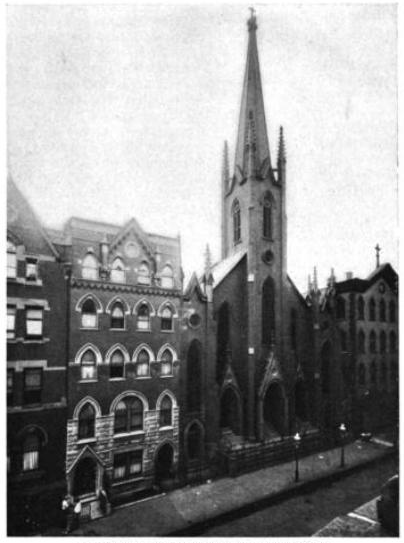
Photograph of St. Nicholas showing Second Street, just west of Avenue A. The church and almost all buildings on the street were demolished in the 1960s and replaced with parking lots
The East Village's performance and art scene has declined since its height in the 1970s and 1980s.[26] One club that tried to resurrect the neighborhood's past artistic prominence was Mo Pitkins' House of Satisfaction, part-owned by Jimmy Fallon of the Tonight Show and formerly of Saturday Night Live. The venue's past performers include figures such as Murray Hill, Rob Corddry, Rachel Dratch, Amy Poehler, Moby, and Debbie Harry.[27] It closed in 2007. A study done by Fordham University notes the decline of the East Village performance and art scene, and how "the young, liberal culture that once found its place on the Manhattan side of the East River" has shifted in part to new neighborhoods like Williamsburg in Brooklyn.[28][29] Rapture Cafe also shut down in April 2008, and the neighborhood lost an important performance space and gathering ground for the gay community. There are still some performance spaces, such as Sidewalk Cafe on 6th Street and Avenue A, where downtown acts find space to exhibit their talent, and the poetry clubs Bowery Poetry Club and Nuyorican Poets Café.[30]
From 2004 to 2009, the art gallery American Painting, located on East 6th Street between 2nd and 3rd Avenues, exhibited the works of several New York and American artists, namely Andrei Kushnir, Michele Martin Taylor, Carol Spils, Barbara Nuss, Joachim Marx, Stevens Jay Carter and Michael Francis.[31] One of their last exhibits, "East Village Afternoon", depicted local interiors, exteriors, and scenes of the changing neighborhood.[32]
Gentrification and preservation
In the late 20th and early 21st centuries, East Village became gentrified. One theory behind the area's gentrification is that the influx of artists and bohemians attracted more affluent residents, which drives up the price of housing, and begins to drive out the residents who "turned over" the neighborhood.[33][34] Over the course of time, the demographic shift began to change the essential character of the neighborhood, making it safer, more comfortable, less tolerant of noise, and less "edgy". Some gentrification opponents say that this process causes the neighborhood to lose its unique identity for the sake of money.[35] For instance, as part of the gentrification process, some buildings in the area were torn down and replaced by newer buildings.[36] One example of this was in 2010, when actor David Schwimmer bought an 1852 townhouse on 6th Street and completely rebuilt it, despite having received several notices of its possible landmark status.[37]
Rezoning
Due to the gentrification of the neighborhood, parties including the Greenwich Village Society for Historic Preservation (GVSHP), Manhattan Community Board 3, the East Village Community Coalition, and City Councilmember Rosie Mendez, began calling for a change to the area's zoning in the first decade of the 21st century. The city first released a draft in July 2006, which concerned an area bounded by East 13th Street on the north, Third Avenue on the west, Delancey Street on the south, and Avenue D on the east.[38][39] The rezoning proposal was done in response to concerns about the character and scale of some of the new buildings in the neighborhood.[40] The rezoning process and hearings were marked by protests and accusations of promoting gentrification and increased property values over the area's history as a home to New York's low-income immigrant communities and their needs for affordable housing. In particular, residents of Chinatown expressed concerns that blocking the the construction of tall, slender towers in the East Village would result in such development being built in mostly-commercial Chinatown instead.
The rezoning was approved in 2008.[40] Among other things, The zoning established height limits for new development throughout the affected area, modified allowable density of real estate, capped air rights transfers, eliminated the current zoning bonus for dorms and hotels, and created incentives for the creation and retention of affordable housing.[41]}
Landmark efforts
Successes
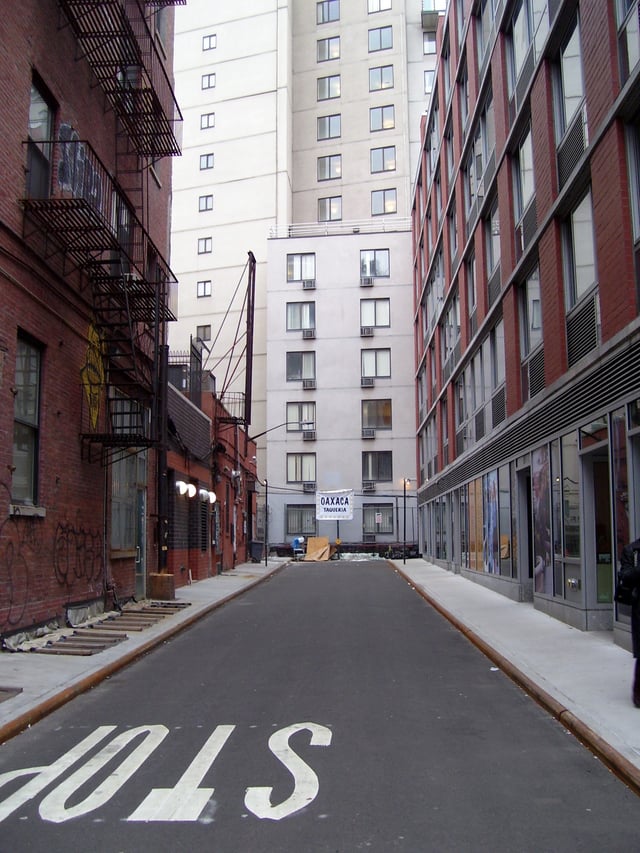
"Extra Place", an obscure side street off of East 1st Street, just east of the Bowery
Local community groups such as the GVSHP are actively working to gain individual and district landmark designations for the East Village to preserve and protect the architectural and cultural identity of the neighborhood. The GVSHP has undertaken a complete survey of the East Village, documenting the history of every single building in the area.[42] In the spring of 2011, the New York City Landmarks Preservation Commission (LPC) proposed two East Village historic districts: a small district along the block of 10th Street that lies north of Tompkins Square Park North, and one larger district focused around lower Second Avenue that originally encompassed 15 blocks and 330 buildings.[43] before later being expanded.[44] In January 2012, the East 10th Street Historic District was designated by the LPC,[45][8] and that October, the East Village/Lower East Side Historic District – the larger district – was also designated by the LPC.[13]
Preservation and community groups of the East Village seek to have other buildings landmarked, including parts of St. Mark's Place, the blocks to the north, and more of the streets bordering Tompkins Square Park.[46] Other successful efforts to retain the neighborhood's low-rise character by controlling development include the East Village downzoning of 2008 and the 3rd/4th Avenue Corridor downzoning, effective in 2010.[47]
Several notable buildings are designated as individual landmarks, some due to the GVSHP's efforts. These include:
The First Houses at East 3rd Street and Avenue A, the country's first public housing development, built in 1935 and designated in 1974[48]
The Stuyvesant Polyclinic at 137 Second Avenue, built in 1884 and designated in 1976[49]
The Children's Aid Society's Tompkins Square Lodging House for Boys and Industrial School at 296 East 8th Street, built in 1886 and designated in 2000[50]
Public School 64 at 350 East 10th Street, a French Renaissance Revival public school built in 1904-1906 by architect and school superintendent C.B.J. Snyder, designated in 2006[51]
Webster Hall, a Romanesque Revival concert hall and nightclub designed in 1886,[52] designated in 2008[53]
The Children's Aid Society's Elizabeth Home for Girls at 308 East 12th Street, built in 1891-1892 and designated in 2008[54]
The Wheatsworth Bakery Building, built in 1927-1928 and designated in 2008[55]
The St. Nicholas of Myra Church at 288 East 10th Street, designated in 2008[56]
The Van Tassell and Kearney Horse Auction Mart at 126-128 East 13th Street, a horse auction mart built in 1903-1904, designated in 2012[57]
Failures

East 5th Street between Second Avenue and Cooper Square is a typical side street in the heart of the East Village
Landmark efforts have included a number of losses as well. Despite the request of GVSHP and allied groups in 2012 for landmarking of Mary Help of Christians school, church and rectory, with parts dating to 1850 and designed by Nicholas Serracino, demolition of the site had begun by by July 2013. A new development including residences and ground-floor retail was to fill the site.[58] In 2011, an early 19th-century Federal house at 35 Cooper Square — one of the oldest on the Bowery and in the East Village — was demolished to make way for a college dorm, over requests of community groups and elected officials.[59]
The Landmarks Preservation Commission acts on no particular schedule, leaving some "calendared" requests for designation open indefinitely, such as the 1886 Tifereth Israel synagogue.[60] Sometimes it simply declines requests for consideration,[61] as it did regarding an unusually intact Italianate tenement at 143 E. 13th Street.
2015 gas explosion
On March 26, 2015, a gas explosion occurred on Second Avenue due to a leaky gas line that was found to be tapped.[62] The explosion and resulting fire destroyed three buildings at 119, 121 and 123 Second Avenue, between East 7th Street and St. Marks Place. At least twenty-two people were injured, four critically, and two people were found dead.[63][64] Three restaurants were also destroyed in the explosion.[65]
Geography
Neighboring the East Village are the Lower East Side to the south, NoHo to the west, Stuyvesant Park to the northwest, and Stuyvesant Town to the northeast.[66]
Subsections
The East Village contains several smaller vibrant communities, each with its own character.
Alphabet City
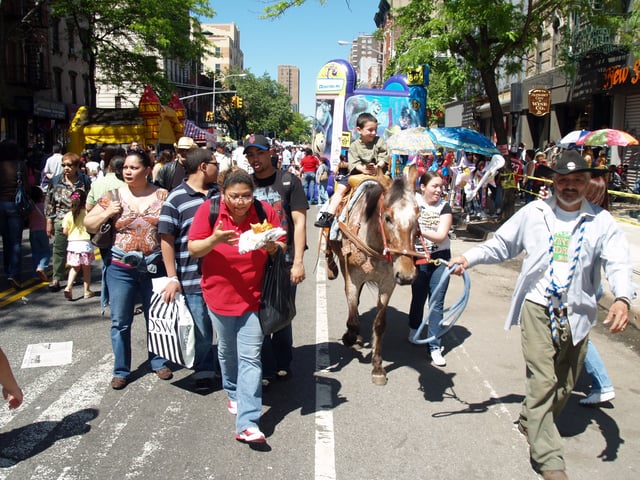
A Loisaida street fair in the summer of 2008.
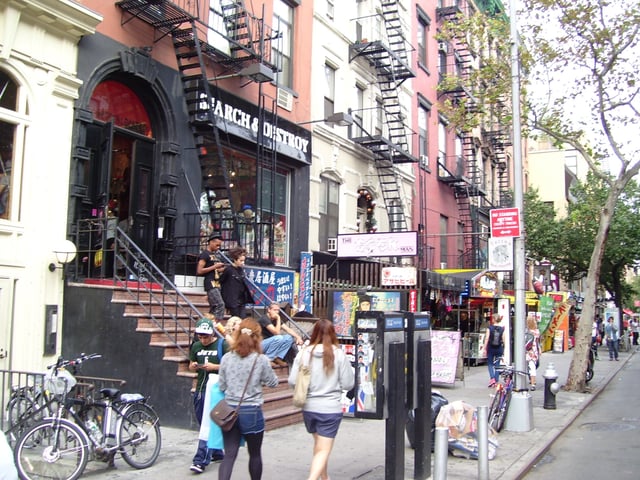
St. Marks Place is a major shopping street, with many businesses that cater to the tourist trade
Alphabet City is the eastern section of East Village that is so named because it contains avenues with single-lettered names, i.e. Avenues A, B, C, and D. It is bordered by Houston Street to the south and 14th Street to the north. Notable places within Alphabet City include Tompkins Square Park and the Nuyorican Poets Café.[67][68][69]
Alphabet City was once the archetype of a dangerous New York City neighborhood. Its turn-around was cause for The New York Times to observe in 2005 that Alphabet City went "from a drug-infested no man's land to the epicenter of downtown cool."[70] This part of the neighborhood has long been an ethnic enclave for Manhattan's German, Polish, Hispanic, and Jewish populations. Crime went up in the area in the late 20th century but then declined in the 21st century, as the area became gentrified.[71]
Alphabet City's alternate name Loisaida is a term derived from the Latino, and especially Nuyorican, pronunciation of "Lower East Side". The term was originally coined by poet/activist, Bittman "Bimbo" Rivas in his 1974 poem "Loisaida". Loisaida Avenue is now an alternative name for Avenue C.[72] Alphabet City also contains ,St. Marks Place, the alternate name of Eighth Street east of Third Avenue. It is named after St. Mark's Church in-the-Bowery, which was built on Stuyvesant Street but is now on 10th Street. The street contains a Japanese street culture; an aged punk culture and CBGB's new store; the former location of one of New York City's only Automats;[73] and a portion of the "Mosaic Trail", a trail of 80 mosaic-encrusted lampposts that runs from Broadway down Eighth Street to Avenue A, to Fourth Street and then back to Eighth Street.[74]
Bowery
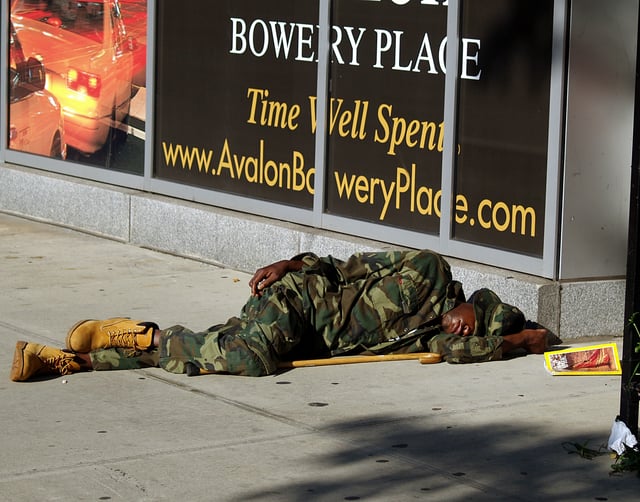
Once synonymous with "Bowery Bums", the Bowery area has become a magnet for luxury condominiums as the East Village neighborhood's rapid gentrification continues
The Bowery was once known for its many homeless shelters, drug rehabilitation centers and bars. The phrase "On the Bowery", which has since fallen into disuse, was a generic way to say one was down-and-out.[75]
The Bow’ry, The Bow’ry!They say such things,and they do strange thingson the Bow’ry— From the musical A Trip to Chinatown, 1891[76]
Today, the Bowery has become a boulevard with new luxury condominiums. Redevelopment of the avenue from flophouses to luxury condominiums has met resistance from long-term residents, who agree the neighborhood has improved but its unique, gritty character is disappearing.[77] The Bowery has also become an area with a diverse artistic community. It is the location of the Bowery Poetry Club, where artists Amiri Baraka and Taylor Mead have held regular readings and performances,[78] and until 2006 was home to the punk-rock nightclub CBGB.[79]
Little Ukraine

Taras Shevchenko Place, with St. George's Church on the north side, and St. George Academy on the south side.
Little Ukraine is an ethnic enclave in the East Village, which has served as a spiritual, political and cultural epicenter for several waves of Ukrainian Americans in New York City as far back as the late 19th century. At the beginning of the 20th century, Ukrainian immigrants began moving into areas previously dominated by fellow Eastern European and Galician Jews, as well as the Lower East Side's German enclave. After World War II, the Ukrainian population of the neighborhood reached 60,000,[80] but as with the city's Little Italy, today the neighborhood consists of only a few Ukrainian stores and restaurants. Today, the East Village between Houston and 14th Street, and Third Avenue and Avenue A[81] still houses nearly a third of New York City's Ukrainian population.[82]
Little Ukraine itself is traditionally defined as
East 7th Street, between Third Avenue and Avenue A;
East 6th Street, between Third Avenue and Second Avenue;
Second Avenue, between East 14th Street and East 4th Street;
Taras Shevchenko Place
Since the early 20th century, St. George Ukrainian Catholic Church has served as the anchor of Little Ukraine, offering daily liturgies and penances, and operating the adjoining St. George Academy, a coeducational parochial school. Starting in 1976, the church has sponsored an annual Ukrainian Heritage Festival, regularly described as one of the few remaining authentic New York City street fairs.[83] In April 1978, the New York City Council renamed a small connecting street between East 7th Street and East 6th Street after Taras Shevchenko, Ukraine's national bard.[84]
Political representation
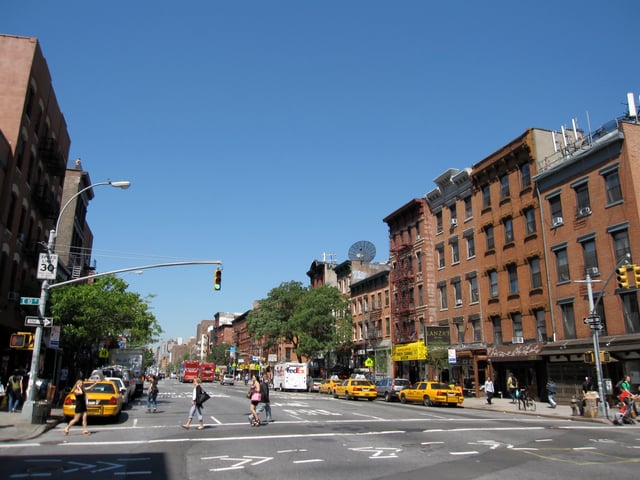
1st Avenue, looking north at 10th Street
Demographics
Based on data from the 2010 United States Census, the population of East Village was 44,136, a change of 2,390 (5.4%) from the 41,746 counted in 2000. Covering an area of 250.02 acres (101.18 ha), the neighborhood had a population density of 176.5 inhabitants per acre (113,000/sq mi; 43,600/km2).[92] The racial makeup of the neighborhood was 65.5% (28,888) White, 3.9% (1,743) African American, 0.1% (64) Native American, 14.9% (6,560) Asian, 0% (22) Pacific Islander, 0.4% (182) from other races, and 2.8% (1,214) from two or more races. Hispanic or Latino of any race were 12.4% (5,463) of the population.[4]
The entirety of Community District 3, which comprises East Village and the Lower East Side, had 171,103 inhabitants as of NYC Health's 2018 Community Health Profile, with an average life expectancy of 82.2 years.[93] [] This is higher than the median life expectancy of 81.2 for all New York City neighborhoods.[94] [] [95] Most inhabitants are adults: a plurality (35%) are between the ages of 25–44, while 25% are between 45–64, and 16% are 65 or older. The ratio of youth and college-aged residents was lower, at 13% and 11% respectively.[93] []
As of 2017, the median household income in Community District 3 was $39,584,[96] though the median income in East Village individually was $74,265.[3] In 2018, an estimated 18% of East Village and Lower East Side residents lived in poverty, compared to 14% in all of Manhattan and 20% in all of New York City. One in twelve residents (8%) were unemployed, compared to 7% in Manhattan and 9% in New York City. Rent burden, or the percentage of residents who have difficulty paying their rent, is 48% in East Village and the Lower East Side, compared to the boroughwide and citywide rates of 45% and 51% respectively. Based on this calculation, as of 2018, East Village and the Lower East Side are considered to be gentrifying.[93] []
Culture
Ethnicity and religion
On October 9, 1966, A.C. Bhaktivedanta Swami Prabhupada, founder of the International Society for Krishna Consciousness, held the first recorded outdoor chanting session of the Hare Krishna mantra outside of the Indian subcontinent at Tompkins Square Park.[97] This is considered the founding of the Hare Krishna religion in the United States, and the large tree close to the center of the Park is demarcated as a special religious site for Krishna adherents.[97] The late poet Allen Ginsberg, who lived and died in the East Village, attended the ceremony.
Several Roman Catholic churches in the East Village have fallen victim to financial hardship in the last decade. Unable or unwilling to maintain them, the Roman Catholic Church has shuttered St. Mary's Help of Christians on East 12th Street, as well as St. Ann's. There has recently been much controversy over St. Brigid's, the historic parish on Tompkins Square Park. One of the mainstays that remains active is St. Stanislaus, just steps from Tompkins Square Park.
Cultural institutions
Neighborhood festivals
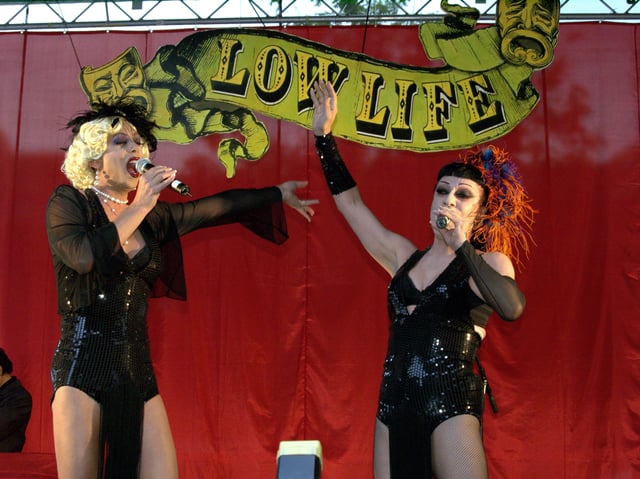
Sherry Vine and Joey Arias during the 2009 HOWL! Festival
Parks and gardens
Tompkins Square Park

Tompkins Square Park is the recreational and geographic heart of the East Village. It has historically been a part of counterculture, protest and riots
Tompkins Square Park is a 10.5 acres (42,000 m2) public park in the Alphabet City section of East Village. It is bounded on the north by 10th Street, on the east by Avenue B, on the south by 7th Street, and on the west by Avenue A.[110] It contains the city's first dog run, which is a social scene unto itself.[111] The park has been the site of numerous events and riots:
On January 13, 1874, a riot broke out after the New York City Police Department clashed with a demonstration involving thousands of unemployed civilians.[112]
On July 25, 1877, during the Great Railroad Strike of 1877, twenty thousand people gathered in the park to hear communist orators speak. New York City police and National Guardsmen eventually charged the crowd with billy clubs, later claiming that the rally was not being held in a peaceful manner. In the wake of this "riot," the City, in conjunction with the War Department, established an official city armory program led by the 7th Regiment.[113]
On August 6-7, 1988, a riot broke out between police and groups of "drug pushers, homeless people and young people known as 'skinheads'" who had largely taken over the park. The neighborhood was divided about what, if anything, should be done about it.[114] Manhattan Community Board 3 adopted a curfew for the previously 24-hour park in an attempt to bring it under control.[115] A rally against the curfew resulted in several clashes between protesters and police.[116]
East River Park
East River Park is 57 acres (230,000 m2) and runs between the FDR Drive and the East River from Montgomery Street to East 12th Street. It was designed in the 1930s by Robert Moses, who wanted to ensure there was parkland on the Lower East Side.[117]
Community gardens
There are reportedly over 640 community gardens in New York City—gardens run by local collectives within the neighborhood who are responsible for the gardens' upkeep—and an estimated 10 percent of those are located on the Lower East Side and East Village alone.[118]
Open Road Park
A former cemetery and bus depot, Open Road Park is a garden and a playground occupying the width of a city block.
Tower of Toys on Avenue B
The Avenue B and 6th Street Community Garden is one of the neighborhood's more notable for a now-removed outdoor sculpture, the Tower of Toys, designed by artist and long-time garden gate-keeper Eddie Boros. Boros died April 27, 2007.[119] The Tower was controversial in the neighborhood; some viewed it as a masterpiece, others as an eyesore.[119][120] It was a makeshift structure, 65 feet high, assembled of wooden planks. The "toys" suspended from it were an amalgamation of fanciful objects found on the street (Boros was a strong voice for reusing and recycling). The fantastical, childlike feeling of this installation was fitting, considering that the garden boasts a children's adventure playground and garden.[121] The tower appeared in the opening credits for the television show NYPD Blue and also appears in the musical Rent.[119] In May 2008, it was dismantled. According to NYC Parks Commissioner Adrian Benepe, the tower was rotting and thus a safety hazard.[122] Its removal was seen by some as a symbol of the neighborhood's fading past.[122]
Toyota Children's Learning Garden
Located at 603 East 11th Street, the Toyota Children's Learning Garden is not technically a community garden, but it also fails to fit in the park category. Designed by landscape architect Michael Van Valkenburgh, the garden opened in May 2008 as part of the New York Restoration Project and is designed to teach children about plants.[123]
La Plaza Cultural
La Plaza Cultural de Armando Perez (La Plaza Cultural) is a community garden, open-air theater and green space in the East Village.
Marble cemeteries
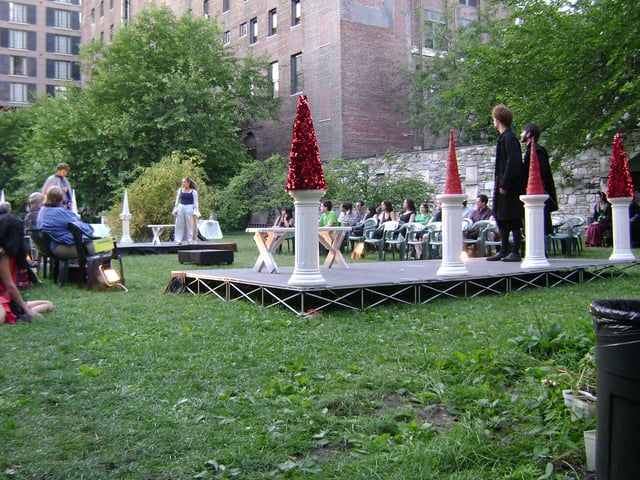
A production of John Reed's All the World's a Grave in the New York Marble Cemetery, which does not contain headstones
The New York City Marble Cemetery, located on 2nd Street between First Avenue and Second Avenue, is the second oldest nonsectarian cemetery in New York City. The cemetery opened in 1831. U.S. President James Monroe was interred there.[124] Others interred there include Stephen Allen, mayor (1821–1824); James Lenox, whose personal library became part of the New York Public Library; Isaac Varian, mayor (1839–1841); Marinus Willet, Revolutionary War hero; and Preserved Fish, a well-known merchant.[124]
Police and crime
East Village is patrolled by the 9th Precinct of the NYPD, located at 321 East 5th Street.[127] The 9th Precinct ranked 58th safest out of 69 patrol areas for per-capita crime in 2010.[128] With a non-fatal assault rate of 42 per 100,000 people, East Village and the Lower East Side's rate of violent crimes per capita is less than that of the city as a whole. The incarceration rate of 449 per 100,000 people is higher than that of the city as a whole.[93] []
The 9th Precinct has a lower crime rate than in the 1990s, with crimes across all categories having decreased by 78.3% between 1990 and 2018. The precinct saw 0 murders, 40 rapes, 85 robberies, 149 felony assaults, 161 burglaries, 835 grand larcenies, and 32 grand larcenies auto in 2018.[129]
Fire safety

Ladder Co. 3/Battalion 6
East Village is served by four New York City Fire Department (FDNY) fire stations:[130]
Health
Preterm and teenage births are less common in East Village and the Lower East Side than in other places citywide. In East Village and the Lower East Side, there were 82 preterm births per 1,000 live births (compared to 87 per 1,000 citywide), and 10.1 teenage births per 1,000 live births (compared to 19.3 per 1,000 citywide).[93] [] East Village and the Lower East Side have a low population of residents who are uninsured. In 2018, this population of uninsured residents was estimated to be 11%, slightly less than the citywide rate of 12%.[93] []
The concentration of fine particulate matter, the deadliest type of air pollutant, in East Village and the Lower East Side is 0.0089 milligrams per cubic metre (8.9×10−9 oz/cu ft), more than the city average.[93] [] Twenty percent of East Village and Lower East Side residents are smokers, which is more than the city average of 14% of residents being smokers.[93] [] In East Village and the Lower East Side, 10% of residents are obese, 11% are diabetic, and 22% have high blood pressure—compared to the citywide averages of 24%, 11%, and 28% respectively.[93] [] In addition, 16% of children are obese, compared to the citywide average of 20%.[93] []
Eighty-eight percent of residents eat some fruits and vegetables every day, which is about the same as the city's average of 87%. In 2018, 70% of residents described their health as "good," "very good," or "excellent," less than the city's average of 78%.[93] [] For every supermarket in East Village and the Lower East Side, there are 18 bodegas.[93] []
Post offices and ZIP codes
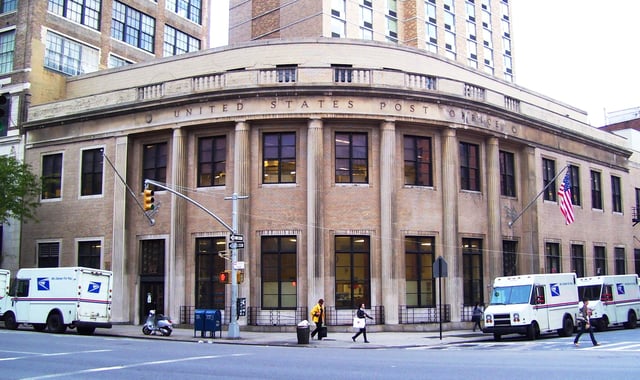
USPS Cooper Station post office
East Village is located within two primary ZIP Codes. The area east of First Avenue including Alphabet City is part of 10009, while the area west of First Avenue is part of 10003.[137] The United States Postal Service operates three post offices in East Village:
Education
East Village and the Lower East Side generally have a higher rate of college-educated residents than the rest of the city. A plurality of residents age 25 and older (48%) have a college education or higher, while 24% have less than a high school education and 28% are high school graduates or have some college education. By contrast, 64% of Manhattan residents and 43% of city residents have a college education or higher.[93] [] The percentage of East Village and the Lower East Side students excelling in math rose from 61% in 2000 to 80% in 2011, and reading achievement increased from 66% to 68% during the same time period.[141]
East Village and the Lower East Side's rate of elementary school student absenteeism is lower than the rest of New York City. In East Village and the Lower East Side, 16% of elementary school students missed twenty or more days per school year, less than the citywide average of 20%.[94] [] [93] [] Additionally, 77% of high school students in East Village and the Lower East Side graduate on time, more than the citywide average of 75%.[93] []
Schools
The New York City Department of Education operates public schools in East Village as part of Community School District 1.[142] District 1 does not contain any zoned schools, which means that students living in District 1 can apply to any school in the district, including those in the Lower East Side.[143][144]
The following public elementary schools are located in East Village and serve grades PK-5 unless otherwise indicated:[142]
PS 15 Roberto Clemente[145]
PS 19 Asher Levy[146]
PS 34 Franklin D Roosevelt (grades PK-8)[147]
PS 63 STAR Academy[148]
PS 64 Robert Simon[149]
PS 94 (grades K-8)[150]
PS 188 The Island School (grades PK-8)[151]
Earth School[152]
Neighborhood School[153]
The Children's Workshop School[154]
The East Village Community School[155]
The following middle and high schools are located in East Village:[142]
Libraries
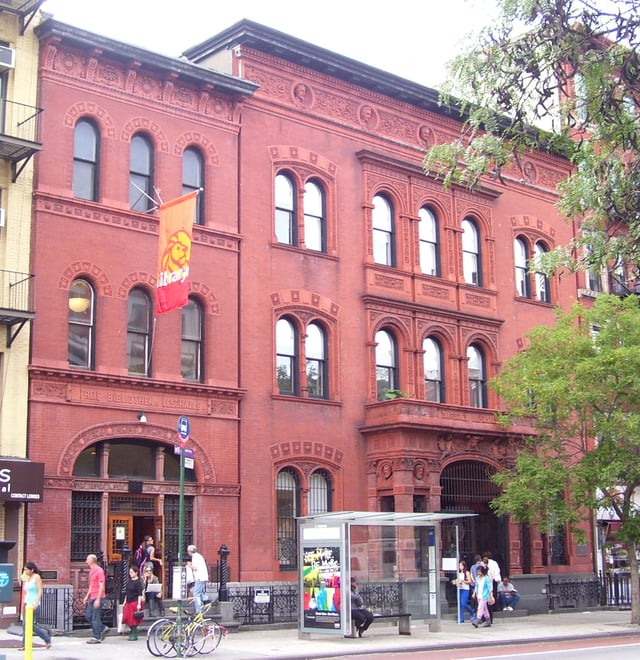
New York Public Library, Ottendorfer branch
The New York Public Library (NYPL) operates three branches near East Village.
The Ottendorfer branch is located at 135 Second Avenue. The branch was the first public library in the city, having opened in 1884 based on a gift from Oswald Ottendorfer, who owned a German-language newspaper. The Ottendorfer branch, designed in the Queen Anne and Renaissance Revival styles, is a New York City designated landmark.[159]
The Tompkins Square branch is located at 331 East 10th Street. The library opened in 1887 and moved three times before relocating to its current Carnegie library structure in 1904.[160]
The Hamilton Fish Park branch is located at 415 East Houston Street. It was originally built as a Carnegie library in 1909, but was torn down when Houston Street was expanded; the current one-story structure was completed in 1960.[161]
Colleges
New York University
Along with gentrification, the East Village has seen an increase in the number of buildings owned and maintained by New York University, particularly dormitories for undergraduate students, and this influx has given rise to conflict between the community and the university.[162]
St. Ann's Church, a rusticated-stone structure with a Romanesque Revival tower on East 12th Street that dated to 1847, was sold to NYU to make way for a 26-story, 700-bed dormitory. After community protest, the university promised to protect and maintain the church's original facade; and so it did, literally, by having the facade stand alone in front of the building, now the tallest structure in the area.[162] According to many residents, NYU's alteration and demolition of historic buildings, such as the Peter Cooper Post Office, is spoiling the physical and socio-economic landscape that makes this neighborhood so interesting and attractive.[163]
NYU has often been at odds with residents of both the East and West Villages due to its expansive development plans; urban preservationist Jane Jacobs battled the school in the 1960s.[164] "She spoke of how universities and hospitals often had a special kind of hubris reflected in the fact that they often thought it was OK to destroy a neighborhood to suit their needs", said Andrew Berman of the Greenwich Village Society for Historic Preservation.[165]
Cooper Union
The Cooper Union for the Advancement of Science and Art, founded in 1859 by entrepreneur and philanthropist Peter Cooper and located on Cooper Square,[166] is one of the most selective colleges in the world,[167] and formerly offered tuition-free programs in engineering, art and architecture.[168][169] Its Great Hall is famous as a platform for historic speeches, notably Abraham Lincoln's Cooper Union speech,[170][171] and its New Academic Building is the first in New York City to achieve LEED Platinum Status.[172]
Transportation
The nearest New York City Subway stations are Second Avenue (F and
Media
Notable residents
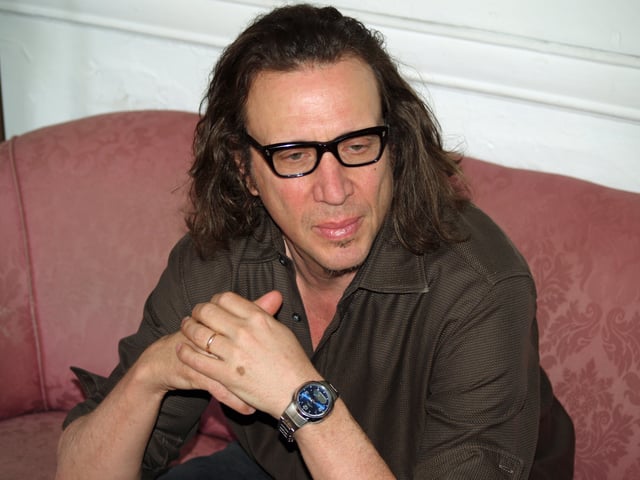
Punk rock icon and writer Richard Hell still lives in the same apartment in Alphabet City that he has had since the 1970s
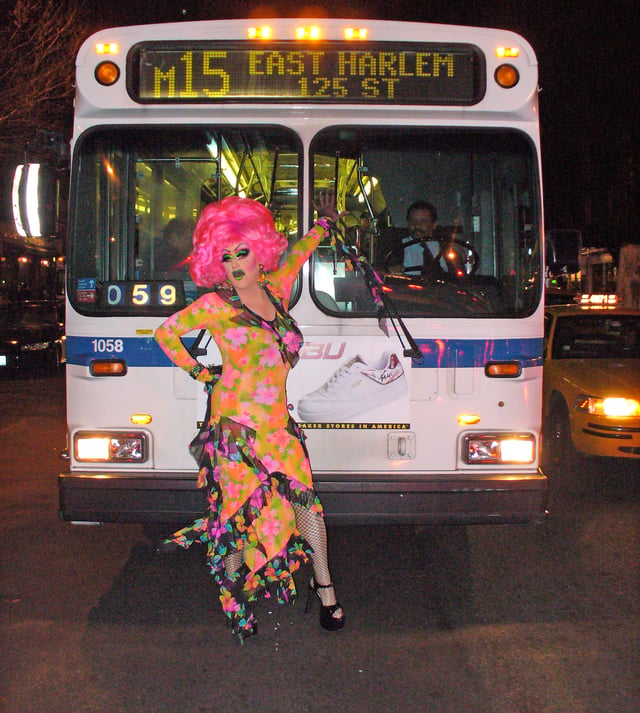
Miss Understood stops a M15 bus in front of the Lucky Cheng's restaurant at 2nd Street on First Avenue.
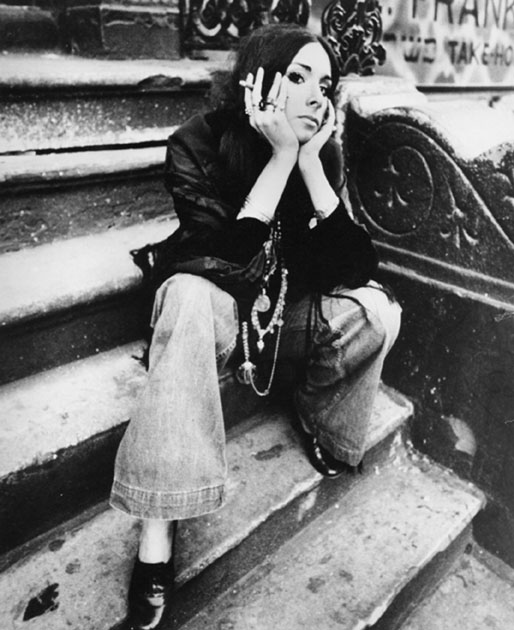
Lotti Golden, Lower East Side, 1968
Ryan Adams – alt-country musician
Darren Aronofsky – filmmaker[176]
W. H. Auden – poet[177]
John Franklin Bardin (1916-1981) – novelist[178]
Dana Beal (born 1947), social and political activist.[181]
Jeremy Blake (1971-2007), digital artist and painter.[182]
Walter Bowart – co-founder and editor of the East Village Other
David Bowes – painter[183]
William Burroughs – novelist, actor
Richard Brookhiser – author, historian
Chris Cain – bassist for the indie-rock band We Are Scientists
Max Cantor – journalist and former actor
Julian Casablancas – musician.[184]
Ching Ho Cheng - artist
Alexa Chung – model, TV presenter
David Cross – actor, comedian
Quentin Crisp – writer, raconteur[185]
Jackie Curtis – writer, poet, actor Warhol superstar
Candy Darling – actress, Warhol superstar
Tory Dent (1958-2005), poet, art critic, and commentator on the AIDS crisis.[186]
Jonathan Larson – musician, composer of the musical Rent
Rosario Dawson – actress, singer and writer
Stan Distenfield – former WNYC radio announcer[37]
Negin Farsad – writer, director, comedian
Barbara Feinman – milliner
Lady Gaga – singer, songwriter
Sharon Gannon and David Life – yoga instructors and co-founders of Jivamukti Yoga school, which originated in the East Village
Allen Ginsberg – Beat Generation poet[187]
Philip Glass – American composer[188]
Lotti Golden -artist, songwriter, poet
Nan Goldin – photographer
Ayun Halliday – actress and writer
Keith Haring – artist
Randy Harrison – actor
Matt Harvey – MLB Pitcher
Richard Hell – musician, author
Abbie Hoffman – 1960s political activist[189]
John Holmstrom – cartoonist and writer, Punk (magazine) editor
Harold Hunter – skateboarder, actor
Sarah Hyland – actress
Jim Jarmusch (born 1953), film director, screenwriter, actor, producer, editor and composer.[190]
Indian Larry (born Lawrence DeSmedt; 1949-2004), motorcycle builder and artist, stunt rider, and biker.[191]
Tom Kalin – filmmaker
Agim Kaba – actor, artist and director
Allan Katzman – co-founder and editor of the East Village Other
Kathy Kemp – fashion designer and entrepreneur
Alvin Klein (c. 1938 - 2009), theater critic for The New York Times.[192]
Vashtie Kola – director
Greg Kotis – playwright
Paul Krassner – publisher of The Realist
Tuli Kupferberg – Beat Generation poet, and one of the original Fugs
Stephen Lack – actor, painter
Ronnie Landfield – painter[193]
Greer Lankton – artist and dollmaker
Phoebe Legere – musician and artist
John Leguizamo – actor and monologist
Frank London – composer, musician
Frank Lovell (1913-1998), communist politician.[194]
John Lurie – musician, painter, actor, producer
Madonna – singer/entrepreneur[195]
Handsome Dick Manitoba – singer, saloon owner
Jimmy McMillan – political activist, founder of "The Rent is Too Damn High Party"
Butch Morris – cornetist, composer and conductor.[196]
Cookie Mueller – actress, model
Joseph Nechvatal – digital artist
Conor Oberst – musician
Claes Oldenburg – sculptor[197]
Tom Otterness – sculptor
Iggy Pop – performer, musician
Adam Purple – creator of the Lower East Side "Garden of Eden"
Daniel Radcliffe – actor
Daniel Rakowitz (the East Side Cannibal) and his victim and roommate, dancer Monicka Beerle
Joey Ramone – musician
Johnny Ramone – musician
Bill Raymond – actor
Lou Reed – musician and songwriter
Joel Resnicoff – artist and fashion illustrator
James Romberger – artist
Mark Ronson – musician
Jerry Rubin – 1960s political activist[189]
Arthur Russell – musician[198]
Ed Sanders – New York School poet and one of the original Fugs
Liev Schreiber – actor
David Schwimmer –Friends actor, and wife, part-time photographer Zoe Buckman[199]
Chloë Sevigny – actress
Sam Shepard (1943-2017), playwright, actor, author, screenwriter, and director[200]
Jack Smith – filmmaker, artist
Kiki Smith – sculptor
John Spacely actor, activist (Junkie, Sid and Nancy, Iboga therapy)
Regina Spektor – singer-songwriter and pianist
Bobby Steele – musician
Frank Stella – painter, maintained as studio in the East Village
Ellen Stewart – founder of La MaMa, E.T.C. (Experimental Theatre Club) in 1961
Adario Strange – writer, director
Michele Martin Taylor - artist[201]
Henry Threadgill – musician[202]
Johnny Thunders - (John Genzale) purveyor of LES street rock, member of NYDolls and The Heartbreakers
Marisa Tomei – actress
Rachel Trachtenburg – singer and musician
Marguerite Van Cook – artist, musician, writer, producer
Arturo Vega – punk rock graphic designer and artistic director.[203]
Steven Vincent – journalist and author who was shot and killed in 2005 while reporting in Iraq.[204]
David Wojnarowicz – painter, photographer, writer, filmmaker, performance artist, songwriter/recording artist and AIDS activist prominent in the New York City art world.[205]
Rachel Weisz – actress and wife of actor Daniel Craig.[206]
Charles Wright – novelist who wrote The Messenger (1963), The Wig (1966) and Absolutely Nothing to Get Alarmed About (1973).[207]
John Zorn – musician and composer.[208]
See also
East Side
East Village/Lower East Side Historic District
Stuyvesant Town–Peter Cooper Village
